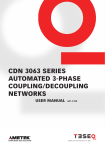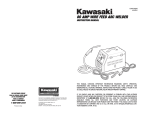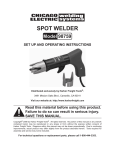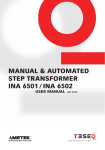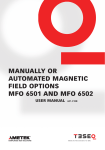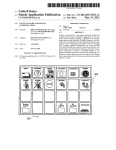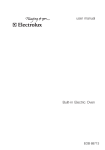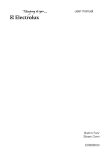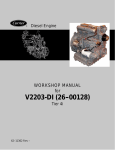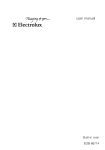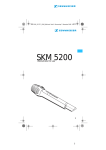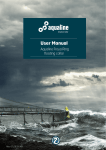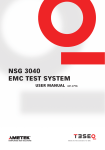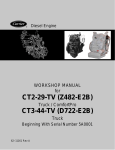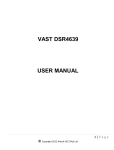Download 601-324C - CDN 3043 User Manual english.indd
Transcript
1 CDN 3043 SERIES AUTOMATED 3-PHASE COUPLING/DECOUPLING NETWORKS USER MANUAL 601-324C CDN 3043 SERIES AUTOMATED 3-PHASE COUPLING/DECOUPLING NETWORKS USER MANUAL 601-324C CDN 3043 series - Automated 3-phase coupling decoupling networks CONTENTS 1 Explanation of the symbols used in this manual 2Introduction 2.1 General description 2.1.1 CDN 3043 automated 3-phase coupling decoupling networks 3 Safety instructions 3.1 General 4Installation 4.1 Installation of a EUT power emergency off switch 5 Applicable safety standards 6 Pulse coupling 6.1. Combination wave and ring wave test 6.1.1 Combination wave (CW) - Surge generator 6.2 Electrical fast transient EFT (burst) 7 First steps 8 Installation of the CDN 3043 9 Main frame description 9.1 Front panel CDN 3043 9.1.1 EUT output connection 9.1.2 Ground reference terminal 9.1.3 Surge input sockets (Fischer connector) 9.1.4 Burst input socket (SHV connector) 9.1.5 LED indicator 9.2 Rear panel 9.2.1 Mains power input and power switch 9.2.2 EUT input supply 9.2.3 3-phase AC EUT mains input 9.2.4 Colour codes of a 3-phase system 9.3 Phase rotation indication 5 7 7 8 8 8 11 12 13 14 14 15 15 17 18 19 19 19 20 20 20 20 21 21 22 22 23 24 9.3.1 2- or 1-phase AC EUT mains input 26 9.3.2 Phase rotation indication using single- or two lines EUT power mains 26 9.3.3 DC EUT input 27 9.3.4 Signal routing card “system in interface” 27 9.3.5 Signal routing card “system out interface” 28 9.3.6 Fan and cooling concept 28 10 Test setup setting 29 10.1 Applicable safety standards 29 10.2 Test execution 30 10.3 General dangers 31 10.4 Dangers concerning the EUT 31 10.5 Test setup 32 10.6 Mounting in a 19” rack 34 11 CDNs setup and coupling mode connection 35 11.1 General 35 11.2 Combination of single phase CDN and three phase CDN 35 11.2.1 NSG 3040 with NSG 3043 35 12 Coupling mode selection at the generator user interface 37 12.1 Surge output/burst output 37 12.2 Manual CDN 37 12.3 IEC coupling 38 12.3.1 User interface setting 38 13 Technical data coupling network CDN 3043 39 13.1Dimensions/weight 39 13.2 Coupling possiblities 40 14 Maintenance and function check 42 14.1 General 42 14.2Cleaning 42 14.3 Function check 43 14.4 Calibration 43 15Warranty 44 16 CE conformity 45 17Accessories 46 18 System limits 49 19Addresses 50 1 EXPLANATION OF THE SYMBOLS USED IN THIS MANUAL Please take note of the following explanations of the symbols used in order to achieve the optimum benefit from this manual and to ensure safety during operation of the equipment. The following symbol draws your attention to a circumstance where nonobservation of the warning could lead to inconvenience or impairment in the performance. Example: This connection must not be confused with the EUT power input. The following symbol draws your attention to a circumstance where nonobservation of the warning could lead to component damage or danger to the operating personnel. Example: Never connect or disconnect the EUT while the test system is performing a test. Never connect or disconnect the coupling path while the test system is performing a test. 5 6 Lethal danger from high voltages and the risk of radiating illegal electromagnetic interference. The NSG 3040/3060 with its CDN may only be installed and used by authorised and trained EMC specialists (electrical engineers). The NSG 3040/3060 with its CDN must only be used for EMC tests as set down in these operating instructions. Personnel fitted with a heart pacemaker must not operate the instrument and must not be in the vicinity of the test rig while it is in operation. Lethal danger from high voltages and the risk of high levels of electromagnetic radiation being generated. The system must only be used for EMC test purposes as set down in these operating instructions. When the system is used in conjunction with options, accessories or other equipment the safety instructions concerning those devices must also be observed. CDN 3043 series - Automated 3-phase coupling decoupling networks 2 INTRODUCTION 2.1 General description The NSG 3040/3060 test systems are designed primarily for cable-borne transient interference tests as specified in the European generic standard IEC/EN 61000-6-1 covering equipment for household, office and light industrial use, and IEC/EN 61000-6-2 for applications in industrial environments, in accordance with the requirements of the basic standard. IEC/EN 61000-4-4, -5, -12 as well as -8 and -9. The EU directive no. 2004/108/EEC (for the assignment of the CE symbol) refers back to this standards for these types of equipment. The CDN 3043 series are modular and automated coupling/decoupling networks, depending on the version it can inject surge and/or burst pulses. The modularity has the advantage that upgrades can be performed at any time in a cost effective way, ensuring a safe investment in future laboratory needs. 2.1.1 CDN 3043 automated 3-phase coupling/decoupling networks The CDN 3043 are automated 3-phase coupling networks, rated for a EUTs of 16 or 32 A. The CDN 3043 series are able to couple combination wave and ring wave surge pulses up to 4.4 kV and EFT up to 4.8 kV. 7 8 3 SAFETY INSTRUCTIONS The coupling networks CDN 3043 are intended for use with surge and/or burst generators. These generators produce high voltage test pulses with high energy. Improper or careless handling can be fatal! The instrument must only be accessible to trained persons. These operating instructions together with the generator manual, form an essential part of the equipment and must be available to the operator at all times. All the safety instructions and advice notes are to be observed. Neither Teseq AG, Luterbach, Switzerland, nor any of the subsidiary sales organisations can accept any liability for personal, material or consequential injury, loss or damage that may result from improper use of the equipment and accessories. 3.1 General Use of the coupling device in combination with the generator is restricted to authorized and trained specialists. The user is directly responsible for ensuring that the test rig does not cause excessive radiated interference which could affect other instrumentation. The test system itself does not produce any excessive EM radiation. However, the injection of interference pulses into a EUT can result in it and/or its associated cables radiating electromagnetic energy. To avoid problems with unwanted radiation the standards organisations recommend that the test rig is operated inside a Faraday cage. CDN 3043 series - Automated 3-phase coupling decoupling networks Because of its type of construction the instrument is not suitable for use in an explosive atmosphere. Persons fitted with a heart pacemaker must not operate the instrument nor approach the test rig while a test is being executed. Only approved accessory items, connectors, adapters, etc. are to be used to ensure save operation. Upon switching on the generator, it will perform a self test. This includes the function of the EUT coupling relays and the detection of the EUT input power for synchronisation. Therefore the EUT output is to be considered as carrying EUT power all the times! The test rig must provide adequate insulation protection for up to 5 kV surge and burst. Particular care should be given to the connections between the CDN and the equipment under test (EUT). The EUT may only be tested when placed inside a suitable protective enclosure which should provide protection against flying fragments, fire and electric shock. The pulse voltage must not be able to find its way to unearthed metal objects in the event of the EUT failing. Only use the instrument in a dry room. Never leave the instrument unattended when the EUT is switched on. Do not open the instrument. Repairs and adjustments must only be carried out by qualified maintenance personnel. 9 10 Do not continue to use the CDN in case of mechanical damage occur. The CDN housing and the cables have both insulating and a screening function, which can only be assured while the housing is intact. Return the damaged CDN to a Teseq service center immediately for repair. CDN 3043 series - Automated 3-phase coupling decoupling networks 4 INSTALLATION The test system conforms to protection class 1. Local installation regulations must be respected to ensure the safe flow of leakage currents. Operation without a protective earth connection is forbidden! Switch off EUT power before accessing EUT power IN or OUT terminals. The terminals of the three phases CDN 3043 is accessible with the included insulated Allen key. Two independent protective earth connections are necessary (for the test system and the EUT). These must be connected back to the local permanent installation or to a fixed, permanent protective earth conductor. Operate the equipment only in dry surroundings. Any condensation that occurs must be allowed to evaporate before putting the equipment into operation. Do not exceed the permissible ambient temperature or humidity levels. Use only officially approved connectors and accessory items. Ensure that a reliable return path for the interference current is provided between the EUT and the generator. The reference ground plane and the earth connections to the instruments, as described in the relevant test standard, serve this purpose well. 11 12 Since the instrument works, on principle, with two independent power supplies (one for the coupling network and one for the EUT), the CDN 3043 must be disconnected from both sources before any modifications to the test rig are undertaken. Besides the mains connections themselves, certain components also operate at high voltages, which are not provided with any form of extra protection against being accidentally touched. 4.1. Installation of a power emergency off switch The CDN itself has an internal power switch to control EUT power ON/OFF, accessible via the user interface or the software, but nerveless, it is recommended to connect the EUT power through a properly rated circuit breaker and an emergency off button as per IEC/EN 61010-1:2001. In order to ensure an easy and quick access, the button should be located close to the test setup and should be clearly and visibly labelled as a device for “Emergency power ON/OFF” switching. The test setup should only be accessible to trained persons. Dimensioning of mains supply and rating of fuse protection of AC or DC power supply must conform with National prescriptions and EUT requirements. Inappropriate arrangement, mounting, cabling or handling of the device under test or the protective elements can make the protective features that are incorporated in the design of the instrument worthless. CDN 3043 series - Automated 3-phase coupling decoupling networks 5 APPLICABLE SAFETY STANDARDS The construction of the instrument conforms to the safety requirements and offers everything necessary for safe and efficient operation. Development and manufacture is in compliance with ISO 9001. The system complies with the safety requirements of IEC/EN 61010-1 (safety requirements for electrical equipment for measurement, control and laboratory use). All mains power driven types of units are designed for high voltage working safety. The interference immunity has been tested in accordance with EN 60326-1. It is the user’s responsibility to ensure that the test rig does not emit excessive electromagnetic interference (EMI) which might affect other items of equipment. The test system itself does not produce any excessive radiation; however, the injection of interference pulses into the EUT can result in the device and/or its associated cables starting to radiate EMI. To avoid radiating unwanted interference the standards organisations recommend that the test rig be operated in a Faraday cage. Since the purpose of the test system is to produce interference signals for interference immunity testing, the requirements in IEC/EN 61000-6-x series concerning limiting the radiated EMI can only be complied with by operating the test system inside a Faraday cage. 13 14 6 PULSE COUPLING Various types of CDN 3043 models are available. TypeDescription CDN 3043-B16: Automated 3-phase coupler for burst only with an EUT current rate of 16 A CDN 3043-S16: Automated 3-phase coupler for combined wave surge only (combination and ring wave) with an EUT current rate of 16 A CDN 3043-C16: Automated 3-phase coupler for burst and surge with an EUT current rate of 16 A CDN 3043-B32: Automated 3-phase coupler for burst and surge with an EUT current rate of 32 A CDN 3043-S32: Automated 3-phase coupler for burst and surge with an EUT current rate of 32 A CDN 3043-C32: Automated 3-phase coupler for burst and surge with an EUT current rate of 32 A 6.1. Combination wave and ring wave test The surge test (in compliance with IEC/EN 61000-4-5,) simulates high voltage/ high energy interference as experienced with a lightning strike. Generally speaking the interference finds its way into the EUT by way of the mains supply. This kind of interference can affect equipment in either of two ways. First, the interference can be coupled directly into the equipment via the mains supply. The interference is conveyed directly from the source (e.g. lightning strike to external power cables). Every item of equipment connected to this power source will be affected by the interference pulses. CDN 3043 series - Automated 3-phase coupling decoupling networks Surge pulse interference can also occur on signal and data lines through coupling effects and electrical discharges. For this, the CDN 117/118 is recommended. The test system enables test to be carried out using both coupling methods. The EUT is connected to the mains power socket on the front panel of the test system for the direct mains injection test. Externally coupled tests require the interference to be superimposed on the EUT power feed cable via an external coupling unit that is connected to the Surge output on the front panel of the system. 6.1.1 Combination wave (CW) - Surge generator The combination wave test involves the generation of high voltage surge pulses as specified in the international standard IEC/EN 61000-4-5. The test pulses are injected directly into the EUT power supply lines. The EUT obtains its power from the EUT power outlet on the CDN of the test system where the voltage has the interference signal superimposed on it. Surge voltage of up to 4.4 kV which follows the 1.2/50 µs curve (opencircuit) Surge current of up to 2.2 kA which follows the 8/20 µs curve (short circuit) 6.2 Electrical fast transient EFT (burst) Burst tests (in compliance with IEC/EN 61000-4-4) simulate the high voltage/high frequency interference pulses typically produced when an inductively loaded switch is operated. Such interference always occurs when a current through an inductive device, e.g. motor, circuit breaker, relay, fluorescent lamp, etc. is switched off. This kind of interference can affect other equipment in either of two ways. First, the interference can be coupled directly into the target equipment via the mains power cable. Second the interference can be transmitted from the source along the mains power cable connected to the target. Interference from the mains can reach any other piece of equipment connected to the same power source in a similar way. 15 16 Alternatively, the interference can be coupled capacitive into any target device in the vicinity. Teseq offers such capacitive coupling clamp device like CDN 8014, CDN 8015 and CDN 3425. The test system enables a test to be carried out using both coupling methods. The EUT is connected to the mains power socket on the front panel of the test system for the direct mains injection test. Capacitive coupled tests require the interference to be superimposed on the EUT power feed cable via an external coupling unit that is connected to the Burst output on the front panel of the system. The coupling network CDN 3043 serves to inject standardized pulses into the mains supply to the device under test called for in the international standard IEC/EN 61000-4-4: Fast transient (Burst) up to 4.8 kV which follows the 5/50 ns curve (50 Ω condition). CDN 3043 series - Automated 3-phase coupling decoupling networks 7 FIRST STEPS This chapter contains a short check-list with steps that should be taken before the instrument is connected to the generator, switched on and put into operation. Check the packaging for signs of damage in transit. Any damage should be reported immediately to the transportation company. Due the weight of the CDN 3043, a two man lift is needed to prevent injury. Lift the CDN 3043 coupling network out of its packaging by taking hold of the front mounted grips. Check, using the following list, that all the items ordered as well as their accessories have been delivered: 1. CDN 3043 coupling network unit 2. Operating instructions 3. 1 Mains power cable for the CDN 4. 1 15 cm grounding ship (to ref. ground) 5. 2 HV cable with Fischer/Fischer connector (in C or S versions) 6. 1 HV cable with SHV/SHV connector (in B or C versions) 7. 1 System cable 8. 1 Allen key for output connector 9. Ordered options Check the instrument for signs of transport damage. Any damage should be reported to the transportation company immediately. 17 18 8 INSTALLATION OF THE CDN 3043 The mains power voltage indicated on the instrument must accord with the local supply voltage (mains voltage: 85–265 VAC, universal power unit, mains frequency: 50–60 Hz). Mains switch Fuse-holder with fuses 2 x 3.1.5 AT Mains power supply To insert a fuse, pull the fuse-holder out of the connector, insert 2 fuse cartridges 2 x 3.15 AT (slow blow) into the holder and put the holder back. Plug the mains cable into a power outlet with a solid earth connection. Place the test system such that there is sufficient free space around the cooling air inlets on both sides and behind the fan outlet on the rear panel switch on and operate as stated in the accompanying instructions. CDN 3043 series - Automated 3-phase coupling decoupling networks 9 MAIN FRAME DESCRIPTION 19 9.1 Front panel CDN 3043 Surge input sockets Burst input socket LED indication EUT output connection Ground reference terminal 9.1.1 EUT output connection Never attempt to connect or disconnect an EUT while a test is being carried out. The power output terminal allows connection of 1-phase to 3-phase -5 lines EUTs. connection for three phase 5 cord EUTs. A suitable “Allen key” to screw /unscrew the power leads is included in the delivery package. CDN 3043-16 EUT current range: Max. wire gauge: Torque: 16 A 10 mm² 6 Nm CDN 3043-32 EUT current range: Max. wire gauge: Torque: 32 A 10 mm² 6 Nm 20 9.1.2 Ground reference terminal As mentioned in the EFT standard IEC 61000-4-4, the generator together with the coupling network has to be placed on a ground reference plane which is connected to earth. A good earth connection between the CDN and the earth reference plate is absolutely essential for performing burst tests correctly. Ground reference terminal. This terminal of the CDN provides a solid earth connection point to the test system. There is no need to connect the earth connector from the generator itself, since the burst and surge connectors provide the reference ground from the generator to the CDN. 9.1.3 Surge input sockets (Fischer connector) These sockets (High, Low) serve to connect the surge signal from the generator to the CDN. The surge output from the generator is potential free (floating). The inner conductor of each connector is the surge high and surge low connection respectively while the outer conductor (screen) is connected to the instruments earth. 9.1.4 Burst input socket (SHV connector) This socket serves to connect the CDN to the burst output connector of the generator. 9.1.5 LED indicator LED indicator function Power on: Pulse: High voltage active: EUT-Power on: Error: Instrument / system in operation Shows the occurrence of a pulses or a test event Shows that high voltage is present in the instrument Indicates when the power supply to the EUT is present at the EUT connector on the front panel Indicates that a system error has occurred CDN 3043 series - Automated 3-phase coupling decoupling networks 9.2 Rear panel 21 Fan Phase rotation indication Mains input and power switch Signal routing card “system in interface” Signal routing card “system out interface” EUT input supply 9.2.1 Mains power input and power switch The main input is the power to the internal electronics of the CDN. This connection must not be confused with the EUT power input. The input contains the mains power input connector, the mains switch and the mains fuses. Before putting the instrument into operation, please make sure that the voltage range shown on the mains input module corresponds with the voltage of the local supply to which the instrument will be connected, and whether the fuses are correctly rated (2 x 3.15 AT). 22 9.2.2 EUT input supply Burst and surge interference signals are coupled into this supply line internally. Special care must be taken to use the right phase line from the EUT input at the EUT output connector. Depending on countries, different colour codes are used. Please refer to the EUT input section in this manual to verify the coding. The power source connected to this connector provides the power for the EUT. Because of the capacitors in the internal coupler, earth leakage currents of up to 4 A can occur in the EUT power supply network. The test system must therefore be correctly earthed and be powered from a supply that is not protected by a residual current detector (RCD). If the CDN test system is connected to a DC power source for the EUT, care must be taken to ensure that the polarity at this connector corresponds with that at EUT power connector. 9.2.3 3-phase AC EUT mains input The EUT main input is equipped with screw terminals type Phoenix HDFK 10-HV with following parameters: Wire gauge Max. current Connection data: 0.5 10 mm²/AWG 20 - 6 76 A Max. voltage Torque 1000 V 1.5 - 1.8 Nm CDN 3043 series - Automated 3-phase coupling decoupling networks 9.2.4 Colour codes of a 3-phase system Conductors of a three phase system are usually identified by a color code, to allow for balanced loading and to assure the correct phase rotation. Colors used may adhere to International Standard IEC 60446, older standards, or to no standard at all, and may vary even within a single installation. For example, in the U.S. and Canada, different color codes are used for grounded (earthed) and ungrounded systems. Countries / L1 L2 L3 Neutral Ground / United States (common practice) Black Red Blue With or gray Green, green/yellow triped or a bare copper wire United States Brown Orange Yellow (Delta) or Violet (Wye) Gray or white Green Canada (mandatory) Red Black Yellow White Green (or bare copper) Canada (isolated 3-phase Orange Brown Yellow White Green Brown Black Grey Blue Green/yellow striped Older European (IEC 60446, Black or Black or varies by country) brown brown Black or brown Blue Green/yellow striped UK until April 2006, Hong Kong until April 2009, South Africa, Malaysia Red Yellow Blue Black Green/Yellow striped (green on installa- Pakistan Red Yellow Blue Black India Red Yello Blue Black Green Blue Black Green/yellow stiped (green on very old installations) Red Light blue Green/yellow striped 5 wire power cord protective earth (alternative practice) installations) Europe and many other countries, including UK from April 2004 (IEC 60446), Hong Kong from Juli 2007 Austalie and New Zealand (per AS/NZS 3000:2000 section 3.8.1) People’s Republic of China (per GB 50303-2002 Section 15.2.2) tions approx. before 1970) Red With (prev. yellow) Yellow Green Green 23 24 Peak impulse voltages of up to 630 V can occur on these power lines. Such voltages can, under certain circumstances, destroy AC/DC power supplies. It is the user’s responsibility to ensure adequate protection being provided at the inputs of the source. 9.3 Phase rotation indication This important and easy to read feature guaranties a correct coupling especially in synchronous mode. The phase rotation identification at the back off the CDN units shows clearly, if all phases are connected and if the rotation of L1, L2 and L3 are correctly set, this important especially in synchronous mode. The phase angle shift of 120° is a function of the actual rotational angle, following a definite order. For clockwise rotation the phase sequence order is 1-2-3. However, if we reverse the rotation winding 2’s waveform will be leading 120° ahead of 1 instead of lagging, so the coupling point of a synchronous coupling will be wrong, since the zero crossing of L1 is measured and calculated for the other lines. The counter clockwise rotation phase sequence is 2-1-3, which is wrong. To test the proper phase rotation of the EUT power input, push the button beside the LED’s - phase rotation will be shown by the Led’s as long the button is pushed. CDN 3043 series - Automated 3-phase coupling decoupling networks This is a correct EUT power setting, all phases are connected (all lines indication are on) and the rotation is right too. The EUT power lines provide all voltage, but the phase rotation is wrong. In this case the exchange of line L1, L2, or L3 will solve the rotation problem. Not all EUT power lines provide power and the phase rotation is wrong too. All phase of the EUT in power need to be checked and re-plugged. 25 26 9.3.1 2- or 1-phase AC EUT mains input The CDN is able to handle also two and single phase power mains. In this case the colour code is different. It is the user’s responsibility to ensure that in two or 1-phase system, the phases are correctly set at the input as well as at the EUT output connector, in this case the phase rotation detector is not able to work properly. Following lines have to be used to guarantee the correct coupling mode selection: 2-phase system: L1; L2; N; PE 1-phase system: L1; N; PE 9.3.2 Phase rotation indication using single- or two lines EUT power mains The phase rotation indication is made for 3-phase EUT power mains. In single or two phase application the indication will show different behave. As soon as the three phase input is used for single or two phase EUT application, the rotation indication will not work, resp. will not indicate properly and always showing error. However, the EUT power mains will anyway go through the CDN with any damage or harm. CDN 3043 series - Automated 3-phase coupling decoupling networks Indication in single-phase mode If L1 is connected then L2 will be dark while L3 will light up softly as well and the red rotation led will be on. Indication in two-phase mode If L1 and L2 are connected then L3 will light up softly as well and the red and green rotation led will be on dimly. 9.3.3 DC EUT input Pin allocation for DC voltages: L1 = Positive (+), N = Negative (-) In the case of DC applications, the positive and negative lines have to be connected to L1 and N respectively. The polarity at this EUT power input connector will be the same as at the EUT output connector. 9.3.4 Signal routing card “system in interface” This connection is used if additional automated accessories need to be connected. Otherwise the termination plug has to be connected and the screws need to be tightened. The termination plug is part of the generator. 27 28 9.3.5 Signal routing card “system out interface” This connection is used if additional automated accessories need to be connected. Otherwise the termination plug has to be connected and the screws need to be tightened. The termination plug is part of the generator. 9.3.6 Fan and cooling concept All Teseq CDN 3043 series instruments have been designed with a dynamic cooling concept. Internal elements suspected to warm up in any condition, especially the Surge pulse decoupling chokes, are equipped with thermal sensors. So at standby or for lower EUT currents, when there are nearly no dissipation losses in the CDN, and so no heat generation, there is no need of cooling and the fans will turn at a very low speed, generating no noise. As soon as the EUT current raises, heat will be generated in the housing, the internal control electronics will detect this and increase fan speed to improve cooling. In case of international or uninternational overloading, there will be a point where even full speed cooling will no more be sufficient, at this moment the CDN 3043 will switch OFF EUT power through the built in EUT power contractor, and so avoid destruction of the instrument (risk of fire). The CDN 3040 control electrics will also send a message back to the NSG 3040 which will immediatly stop the firing of pulses. That way CDN 3043 series give large overload capabilities, allowing up to 1,5 nominal current loading for 10 to 20 minutes, as well as high inrush currents or peak laods. CDN 3043 series - Automated 3-phase coupling decoupling networks 10 TEST SETUP SETTING 10.1 Applicable safety standards The construction of the instrument offers everything necessary for safe and efficient operation. Development and manufacture is in compliance with ISO 9001. The instrument complies with the safety requirements of IEC/EN 61010-1 (Safety requirements for electrical equipment for measurement, control and laboratory use). The interference immunity has been tested in accordance with EN 61326-1. It is the user’s responsibility to ensure that the test rig does not emit excessive electromagnetic interference (EMI) that might affect other items of equipment. The test system itself does not produce any excessive radiation; however, the injection of interference pulses into the EUT can result in the device and/or its associated cables starting to radiate EMI. To avoid radiating unwanted interference the standards organisations recommend that the test rig be operated in a Faraday cage. Since the purpose of the test system is to produce interference signals for interference immunity testing, the requirements in IEC/EN 61000-6-1,-2,-3,-4 concerning limiting the radiated EMI can only be complied with by operating the test system inside a Faraday cage. 29 30 10.2 Test execution During a test, the EUT together with its accessories and cables are to be considered as being live at all times. The test system must be stopped and the EUT supply disconnected before any work is carried out on the EUT. The EUT is to be tested only in a protective cage or under a hood which provides protection against electric shock and all manner of other dangers pertaining to the particular EUT (see: Dangers concerning the EUT). The safety instruction concerning all the instruments and associated equipment involved in the test rig are to be observed. The configuration of the test rig is to be strictly in compliance with the methods described in the relevant standard to ensure that the test is executed in a standard-conforming manner. CDN 3043 series - Automated 3-phase coupling decoupling networks 10.3 General dangers Local burning, arcing, ignition of explosive gases. Danger from the resultant EUT supply current caused by a flashover or breakdown resulting from the superimposed high voltage effects. Dangers from a disrupted EUT. Disturbance of other, unrelated electronics, telecom munications, navigational aids and heart pacemak ers through unnoticed radiation of high frequency energy. In the test system the interference voltage, corresponding to the level called for in the relevant test specification, is superimposed on the EUT’s protective earth conductor. Earth contacts or pins (e.g. as in German and French mains plugs) as well as the EUT earth itself can be at an elevated voltage level that would make touching dangerous. In many power connectors even the screws are linked to the protective earth. 10.4 Dangers concerning the EUT EUTs are often simply functional samples that have not previously been subjected to any safety tests. It can therefore happen in some cases that the EUT is quickly damaged by internal overloads caused by the control electronics being disrupted or it may even start to burn. As soon as the EUT begins to show signs of being disrupted the test should be stopped and the power to the EUT switched off. 31 32 Internal disruption of the electronics can result in the interference voltage or the EUT supply voltage being present on the EUT’s outer casing. Electrical breakdown or arcing from and in plugged connections that is overstressed voltage-wise during the test. Explosion of components with fire or fragmentation as a result of energy dissipated, e.g. from the resultant supply current or ignition of vaporized plastics materials. Faulty behaviour by the EUT, e.g. a robot arm strikes out or a temperature controller fails, etc. 10.5 Test setup Regular setup is the CDN on the test table (or floor) and the generator on top of the CDN. A standardized test setup can be referred at the IEC/EN 61000-4-5 standard. 1. Connect the ground strap of the CDN from the reference ground connector to the ground reference plate of the test setup. A proper earth strip to the CDN it is imperative. For EFT test a proper grounding to the ground reference plane is essential to fulfil standard test requirements. Operation without a protective earth connection is forbidden! 2. The earth connection between the CDN and the generator is realized via the HV connector and/or the EFT connection. No additional earth link from the generator CDN is needed. 3. Connect the surge HV cable and/or the EFT cable between CDN and generator using the delivered cables. CDN 3043 series - Automated 3-phase coupling decoupling networks 4. Connect the 25 pin system cable at the rear of the generator (MCR 3000 System out interface) with the CDN (SCR 3100 System in interface) unit and tighten the screws of this connectors. (The pin setting are described in the NSG 3040 manual). 5. Connect the termination plug to the CDN (SCR 3200 System out interface) to terminate the system. If accessories such as INA, VAR or MFO are used for the test, these may need to be connected at the CDN (SCR 3200 System out interface) and the X1 connector from the accessories and be terminated via termination plug at X2. 6. Connect the mains to the CDN and to the generator. 7. Connect the EUT supply input, use the phase rotation detection to verify proper connection. 8. Use the delivered and insulated allen key to connect the EUT cable on the EUT output of the CDN. Respect the phase L1 for single phase resp. L1, L2, L3 for the three phase connection. Do not forget to check the proper connection to the EUT Earth. Make sure that the EUT is properly connected to the CDN EUT output. 33 34 To ensure a proper recognition of the automated accessories and CDN, the generator is the final unit to be switched on. 8. Switch on the mains on CDN first, then the generator. 9. Start test procedure. 10.6 Mounting in a 19” rack For system use, i.e. when the NSG 3040 test system is to be combined with other equipment, it can be useful to mount the instrument in a 19“ rack. The width of the unit fits the 19“ rack system and the height is 5HU for the NSG 3040 and 7U for the CDN 3043. For ordering information please refer to the section “Accessories”. CDN 3043 series - Automated 3-phase coupling decoupling networks 11 CDNS SETUP AND COUPLING MODE CONNECTION 11.1 General As long as a CDN 3043 3-phase coupler is connected to the generator, this CDN will always be taken as default unit and the 3-phase coupling modes is shown at the user interface. Since the CDN 3043 can be used as an EFT coupler or a surge coupling only, the user interface will only show the 3-phase menu for the existing coupling modules. 11.2 Combination of 1-phase CDN and 3-phase CDN In case the internal CDN is used, the three phases CDN has to be switched off and the user interface needs to be reset by touching the “Reset Interlock” button in the main menu. 11.2.1 NSG 3040 with CDN 3043 35 36 If a NSG 3040 goes with a CDN 3043 then the 3-phase coupler is default and active in the meaning that surge and EFT pulse will be coupled into the CDN 3043, while the PQT test is available at the NSG 3040 EUT output. Performing PQT test can be realized without disconnecting or switching of the CDN 3043 (internal CDN of NSG 3040 is called CDN 3041). CDN 3043 series - Automated 3-phase coupling decoupling networks 12 COUPLING MODE SELECTION AT THE GENERATOR USER INTERFACE The possible selections are: Surge output or burst output Manual CDN IEC coupling 12.1 Surge output/burst output Depending on the actual selected pulse, the surge output or burst output selection will activate the HV pulse output. No coupling to the EUT lines of the connected CDN will be realised. 12.2 Manual CDN This selection has to be used if an external manual coupler is connected; like CDN 3083 for surge pulse or for burst CDN 163 or CDN 8014/8015 respectively. 37 38 12.3 IEC coupling Touching the coupling line selection field, it will activate a new window with the selection possibilities. 12.3.1 User interface setting Three phase setting windows for burst Three phase setting windows for surge The coupling path will be shown by closed relay signs. By touching the “OK” button the selected coupling will be activated. With “cancel” it will close the window without saving the coupling selection. By touching the button “Show Graphics” it will show the grahically settings. CDN 3043 series - Automated 3-phase coupling decoupling networks 13 TECHNICAL DATA COUPLING NETWORK CDN 3043 13.1 Dimensions/weight ParameterValue EUT VAC line to line: Up to 480 VAC rms, 50 / 60 Hz * EUT VAC line to neutral/ground: Up to 280 VAC rms, 50 / 60 Hz * EUT VDC max: 225 VDC DC current range: Up to 125 VDC – full current range Up to 225 VDC – max. 7 A AC current range: 32 A continous / 45 A for ca. 30 min. EUT supply: Three phase (5 wire) Two phase (4 wire) Single phase (3 wire) Burst voltage: Up to 4800 V Surge voltage: Up to 4400 V Terminals: Screw terminals, rated for 32 A Instrument supply: 85 to 265 VAC, 50 / 60 Hz Size: 449 x 310 x 565 mm Weight: 40 kg approx. Connections: HV-surge pulse input from generator (Fischer connector) EFT connector from generator (SHV connector) Connector for EUT supply (Screw terminals Phoenix) Power inlet for CDN Earth connection * Below 30 V synchronisation not guaranteed, asynchronous mode only 39 40 13.2 Coupling possiblities EUT input connections Combination wave pulse IEC/EN 61000-4-5: Line to ground (12 Ω) 1-phase L1, N, PE 2-phase L1, L2, N, PE 3-phase L1, L2, L3, N, PE L1 _ PE L1 _ PE L1 _ PE N _ PE L2 _ PE L2 _ PE N _ PE L3 _ PE N _ PE Lines to ground (12 Ω) L1, N _ PE L1, L2 _ PE L1, L2 _ PE L1, N _ PE L1, L3 _ PE L2, N _ PE L1, N _ PE L1, L2, N _ PE L2, L3 _ PE L2, N _ PE L3, N _ PE L1, L2, L3 _ PE L1, L2, N _ PE L1, L3, N _ PE L2, L3, N _ PE EUT input connections Line to line (2 Ω) L1 _ N L1 _ L2 L1 _ L2 L1 _ N L1 _ L3 L2 _ N L1 _ N L1, L2 _ N L2 _ L1 L2 _ L3 L2 _ N L3 _ L1 L3 _ L2 L3 _ N L1, L2 _ N L1, L3 _ N L2, L3 _ N L1, L2, L3 _ N CDN 3043 series - Automated 3-phase coupling decoupling networks EFT (Burst Standard coupling all lines to ref ground (GND) IEC/EN 61000-4-4: EFT (Burst) Common mode Any Lines and combination to ref GND: L1, L2, L3, N, PE _ ref GND L1 _ ref GND L2 _ ref GND L3 _ ref GND N _ ref GND PE _ ref GND L1,L2 _ ref GND L1,L3 _ ref GND L1,N _ ref GND L1,PE _ ref GND L2,L3 _ ref GND L2,N _ ref GND L2,PE _ ref GND L3,N _ ref GND L3,PE _ ref GND N, PE _ ref GND L1,L2,L3 _ ref GND L1,L2,N _ ref GND L1;L2,PE _ ref GND L1,L3,N _ ref GND L1,L3,PE _ ref GND L1,N,PE _ ref GND L2,L3,N _ ref GND L2,L3,PE _ ref GND L2,N,PE _ ref GND L3,N,PE _ ref GND L1,L2,L3,N _ ref GND L1,L2,L3,PE _ ref GND L1,L2,N,PE _ ref GND L1,L3,N,PE _ ref GND L2,L3,N,PE _ ref GND 41 42 14 MAINTENANCE AND FUNCTION CHECK 14.1 General There are no adjustable elements accessible to the user for either calibration or maintenance purposes. The housing of the test system must not be opened. Should any maintenance or adjustment become necessary, the whole test system, together with an order or fault report, should be sent in to a Teseq service center. Maintenance by the user is restricted to cleaning the outer housing, performing a function check and verification of the pulse parameters. The only exception concerns the exchange of modules or the upgrading of the system with new modules. In such cases the instructions accompanying the modules are to be strictly observed. 14.2 Cleaning In general a moist cloth is sufficient for cleaning the outer housing. In stubborn cases use a small amount of a mild, non-foaming household cleanser as well. No chemicals should be used for cleaning purposes. Before beginning to clean the test system ensure that it is switched off and the mains power cable is unplugged from the supply. CDN 3043 series - Automated 3-phase coupling decoupling networks 14.3 Function check The safety measures described previously must be strictly observed while carrying out a function check. As soon as the test system is switched on the Power-LED should light up. If this is not the case then please check the mains power connection to the test system as well as the fuses and any other cabling. The instrument automatically carries out a diagnostic routine once it has been successfully switched on.The generator cannot perform any test while the Interlock circuit is open. Pulse generation can be observed at the output connectors by means of an oscilloscope. This is a practical way to check that the system is functioning correctly but should never be used for reference or calibration purposes. Teseq recommends the use of a differential probe type MD 200 or MD 200A and the INA 6560 banana adapter. 14.4 Calibration The combination of high voltages and high frequencies in a single pulse makes the calibration of EMC pulse generators particularly demanding and difficult. Teseq has one of the few accredited test laboratories in Europe, Asia and USA that is in the position to undertake calibrations in this specialized field. 43 44 15WARRANTY Teseq grants a warranty of 2 years on this test system, effective from the date of purchase. During this period, any defective components part will be repaired or replaced free of charge or, if necessary, the test system will be replaced by another of equivalent value. The decision regarding the method of reinstaling the functional capability is at the sole discression of Teseq. Excluded from the warranty are damages or consequential damages caused through negligent operation or use as well as the replacement of parts subject to degradation. The warranty is rendered invalid by any intervention on the part of the customer or a third party. The faulty items are to be returned in their original packaging or other equivalent packaging suitable for the purpose of the foreseen means of transportation. Teseq can accept no responsibility for damage in transit. CDN 3043 series - Automated 3-phase coupling decoupling networks 16 CE CONFORMITY 45 46 17 ACCESSORIES CAS 3025 Calibration set for burts/EFT. Consists of INA 265A: 50 Ohm/1000 to 1 terminator/attenuator, of INA 266: 1000 Ohm/2000 to 1 terminator/attenuator, of coax cable of 1 meter, RG 58, of traceable calibration certificate, user manual and carring case. Full compliant to IEC 64000-4-4. INA 3239 Burst/EFT calibration adapter to connect CDN 3043 and CDN 3063 series to calibration terminatior/attenuator CAS 3025. INA 3236 (former INA 6560) HV-plug adapter set for NSG 3000 series - Surge out to safety Banana, 1 plug to RED banana, 1 plug to black banana. Required for surge pulse calibration (safe and reliable connection to measuring probes - max. applicable surge voltages is 10 kV). Can also be used to build injection probe to couple surge pulses to shielded datalines and EUTs housings, etc. CDN 3043 series - Automated 3-phase coupling decoupling networks 47 INA 3235 Surge calibration adapter (set of 5 pces) to connect CDN 3043 and CDN 3063 series to HV probe MD 200 or current probe MD 300. Can also be used for EUT connection to CDN 3043 and 3063 series via banana plugs, limited to 32 A. MD 200 1000:1 High voltage differential probe 3.5 kV common / 7 kV differential. Delivered in a hard shell suitcase, includes set of batteries, two HV safety probes, user manual, traceable calibration certificate. MD 200A 1000:1 High voltage differential probe 7 kV common/differential. Delivered in a foamed hard shell suitcase. Includes set of batteries, two HV safety croco clamps, user manual, traceable calibration certificate. 48 MD 300 Current sensor for surge current measurement. Ratio of 0.002 V/A @1M Ohm and 0.001 V/A @50 Ohm. For surge peak currents up to 5 ka. Delivered in a hard shell foamed suitcase, includes 1 meter coax cable with BNC termination, 30 cm cable with safety bananas, user manual and traceable calibration certificate. INA 166 Rack mounting brackets (5HU) for NSG 3040 series. INA 167 Rack mounting brackets (7HU) for NSG 3060 series, CDN 30x3 - x16 and x32 series, VAR 3005. INA 3000 Trolley for NSG 3000 series. Convenient accessory to get standalone instruments stacked and mobile through large castors. Static load < 150 kg. CDN 3043 series - Automated 3-phase coupling decoupling networks 18 SYSTEM LIMITS Description: Test system for EMC tests with mains-borne interference in accordance with the IEC/EN 61000-6-1 and 2 standards for burst and surge tests. Operation via touch-screen orsoftware-wise via a PC link Ethernet TCP/IP interface. Pulse output to external coupling networks. Housing for bench-top or rack use. Housing: Bench-top housing made of metal. Supplementary rack-mounting kit. Mains on/off: On/off switch on rear panel of the instrument Indicator LED’s on front panel: Power on: LED, yellow Pulse: LED, green High voltage active: LED, red EUT Power on: LED, green Error: LED, red Safety functions: Main fuses, interlock, EUT fail input Ambient conditions: +5°–40°C, 20–80% relative humidity (non condensing), 68–106 kPa atmospheric air pressure Self-test: Routines for functional self-test Relevant safety standards: IEC/EN 61010-1 safety requirements for electrical equipment used for measurement and control purposes as well as laboratory use Relevant EMC standards: IEC/EN 61000-6-1 and 2; generic standards for electromagnetic interference immunity 49 Manufacturer Teseq AG 4542 Luterbach, Switzerland T + 41 32 681 40 40 F + 41 32 681 40 48 chsales.teseq @ ametek.com China AMETEK Commercial Enterprise (Shanghai) Co., Ltd. Beijing Branch T + 86 10 8526 2111 F + 86 10 8526 2141 chinasales @ teseq.com France AMETEK SAS T + 33 1 30 68 89 00 F + 33 1 30 68 89 99 info.france @ ametek.com Germany Teseq GmbH T + 49 30 5659 8835 F + 49 30 5659 8834 deinfo.teseq @ ametek.com Japan AMETEK Co., Ltd. Nagoya Office T + 81 52 709 5501 F + 81 52 709 5502 cts-japan.sales @ ametek.co.jp Switzerland Teseq AG T + 41 32 681 40 40 F + 41 32 681 40 48 chsales.teseq @ ametek.com Taiwan Teseq (Taiwan) Ltd. T + 886 2 2917 8080 F + 886 2 2917 2626 taiwansales @ teseq.com UK Teseq Ltd. T + 44 845 074 0660 F + 44 845 074 0656 uksales @ teseq.com USA Teseq Inc. T + 1 732 417 0501 F + 1 732 417 0511 Toll free +1 888 417 0501 usasales.cts @ ametek.com © May 2015 Teseq® Singapore Specifications subject to change without AMETEK Singapore Pte Ltd notice. Teseq®, a unit of AMETEK (C/o Teseq Pte Ltd) Compliance Test Solutions, is an ISOT + 65 6484 2388 registered company. Its products are F + 65 6481 6588 designed and manufactured under the singaporesales @ teseq.com strict quality and environmental requirements of the ISO 9001. This document To find your local partner within has been carefully checked. However, Teseq®’s global network, please go to Teseq® does not assume any liability for www.teseq.com errors or inaccuracies.


















































